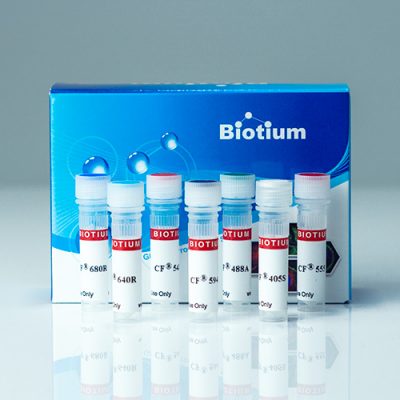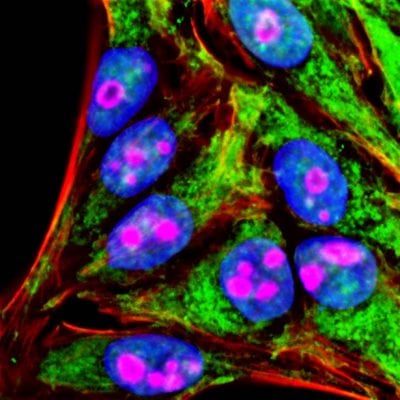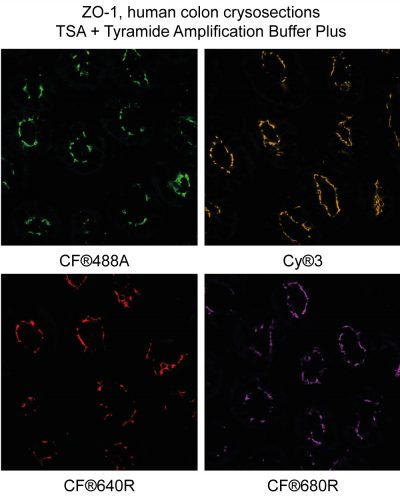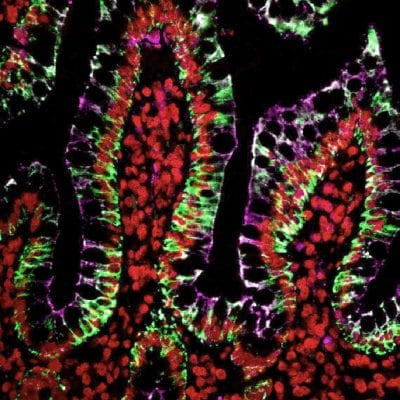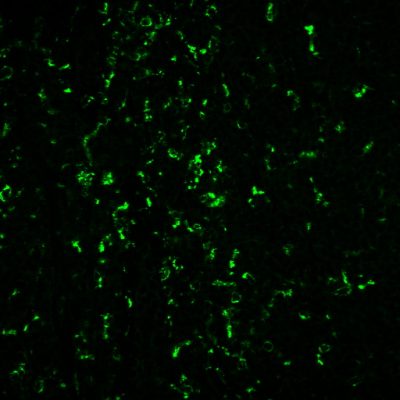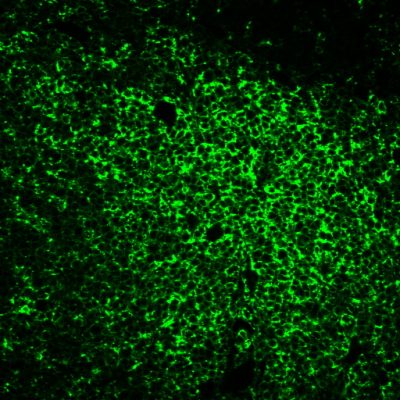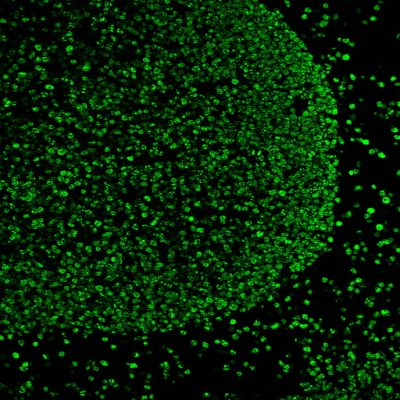CF®488A Tyramide
Cat# 92171
Size : 500UG
Brand : Biotium
CF® Dye Tyramide
Fluorescent CF® Dye tyramides are used for tyramide signal amplification (TSA) for increasing immunofluorescence sensitivity in multicolor immunocytochemistry (ICC), immunohistochemistry (IHC), or in situ hybridization (ISH).
Product Description
CF® Dye tyramide conjugates are used for tyramide signal amplification (TSA), a method for high-density labeling of a target protein or nucleic acid in situ.
- High-density labeling of a target protein or nucleic acid for enhanced immunofluorescence sensitivity
- Especially suited for the detection of low abundance targets
- Detection sensitivity of over 100-fold compared to conventional procedures
- Enables multiplex multicolor detection, not limited by antibodies from the same host species
- Wide selection of bright, photostable and water-soluble CF® Dyes, excellent options for fluorescent labeling
- CF®754 Tyramide is a unique near-IR conjugate compatible with automated staining
We also offer Ready-to-Use Tyramide Amplification Buffer, Tyramide Amplification Buffer Plus (an improved formulation for enhanced TSA sensitivity), and CF® Dye Tyramide Amplification Kits.
Superior CF® Dyes
Biotium’s next-generation CF® Dyes were designed to be highly water-soluble with advantages in brightness and photostability compared to other commercially available fluorescent dyes. Our CF® Dye Tyramide conjugates are available in 21 colors. Learn more about CF® Dyes.
CF®754 Tyramide: A Stable Near-IR Tyramide for Automated Staining
The stability of CF®754 Tyramide in the amplification buffer makes it suitable for staining in automated systems (ie. BOND RX) where the dye may be added to the buffer in advance for several hours to overnight without degradation. CF®754 Tyramide was developed as an alternative to CF®750 Tyramide, which is not stable in the oxidizing amplification buffer. CF®754 is stable in reaction buffer and can be used for automated staining. However, CF®750 Tyramide may still be used if added to the amplification buffer just before use. Near-IR tyramide background staining may be tissue dependent and not suitable for all targets. In general, we would recommend using near-IR staining for more abundant targets in your panel.
Tyramide Signal Amplification
TSA is a highly sensitive method for differential gene or protein analysis or detection of low-abundance targets, in fluorescent ICC, IHC, and FISH applications. An antibody- or streptavidin-HRP conjugate catalyzes the deposition of fluorescent dye/biotin tyramides on tyrosine residues on and adjacent to a target protein or nucleic acid sequence in situ. This results in high-density labeling of the target and significantly improves the detection sensitivity up to 100-fold compared to conventional methods. TSA is particularly advantageous for fluorescence detection in human tissue, where conventional ICC or FISH often fails to provide adequate signal over autofluorescence background. In applications where increased sensitivity is not required, TSA enables the use of significantly lower antibody or probe concentrations for the same level of detection sensitivity thereby reducing issues of non-specific binding or cross-reactivity. Furthermore, since binding of the tyramide label is covalent, a large number of targets can be detected in the same sample using multiple rounds of sequential TSA, in which the availability of antibodies from different host species is not a limitation. TSA also can be easily integrated with conventional immunostaining. Learn more about Tyramide Signal Amplification.
CF® Dye Tyramides
| Product | Ex/Em | Size | Catalog No. |
|---|---|---|---|
| CF®350 Tyramide | 347/448 nm | 0.5 mg | 92170 |
| CF®405S Tyramide | 404/431 nm | 0.5 mg | 92197 |
| CF®405M Tyramide | 408/452 nm | 0.5 mg | 96057 |
| CF®405L Tyramide | 395/545 nm | 0.5 mg | 92198 |
| CF®430 Tyramide | 426/498 nm | 0.5 mg | 96053 |
| CF®488A Tyramide | 490/515 nm | 0.5 mg | 92171 |
| CF®514 Tyramide | 516/548 nm | 0.5 mg | 92199 |
| CF®532 Tyramide | 527/558 nm | 0.5 mg | 96066 |
| CF®543 Tyramide | 541/560 nm | 0.5 mg | 92172 |
| CF®550R Tyramide | 551/577 nm | 0.5 mg | 96077 |
| CF®555 Tyramide | 555/565 nm | 0.5 mg | 96021 |
| CF®568 Tyramide | 562/583 nm | 0.5 mg | 92173 |
| CF®583R Tyramide | 586/609 nm | 0.5 mg | 96085 |
| CF®594 Tyramide | 593/614 nm | 0.5 mg | 92174 |
| CF®620R Tyramide | 617/639 nm | 0.5 mg | 92194 |
| CF®640R Tyramide | 642/662 nm | 0.5 mg | 92175 |
| CF®647 Tyramide | 650/665 nm | 0.5 mg | 96022 |
| CF®660R Tyramide | 663/682 nm | 0.5 mg | 92195 |
| CF®680R Tyramide | 680/701 nm | 0.5 mg | 92196 |
| CF®750 Tyramide* | 755/779 nm | 0.5 mg | 96052 |
| CF®754 Tyramide | 748/793 nm | 0.5 mg | 96090 |
* CF®750 Tyramide is not stable in TSA buffer, and should be added to the buffer immediately before performing the staining reaction.
References
1. Journal of Immunology Research (2020), 2020:2328675. DOI:10.1155/2020/2328675
2. Scientific Reports (2019), 9:1144. DOI:10.1038/s41598-018-38171-5
3. bioRxiv (2019) preprint. DOI:10.1101/651083
4. OncoImmunology (2019), 8(6):e1581528-10. DOI:10.1080/2162402X.2019.1581528
5. Microbiological Research (2018), 217: 69-80. DOI:10.1016/j.micres.2018.08.017
6. Mol Neurodegeneration (2017), 12:68. DOI:10.1186/s13024-017-0202-z
7. Biology Open (2017), 6: 891-896. DOI:10.1242/bio.025809
8. The American Journal of Pathology (2016), 186(10):2650-2664. DOI:10.1016/j.ajpath.2016.06.020
Download a list of CF® Dye references.




